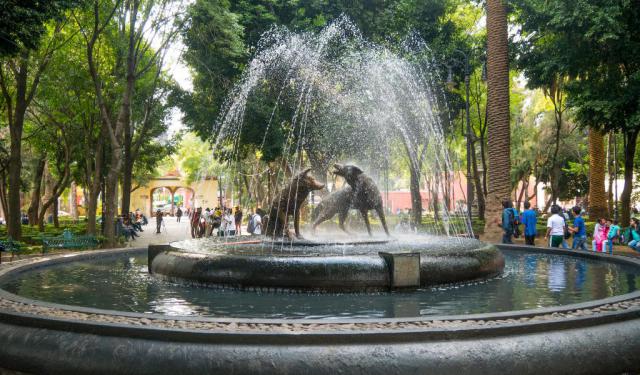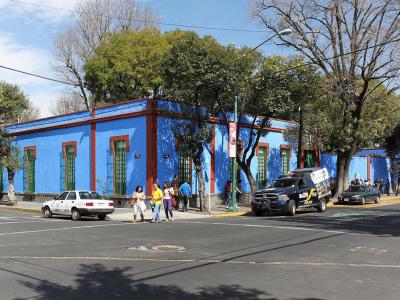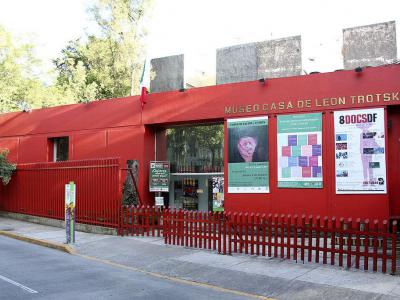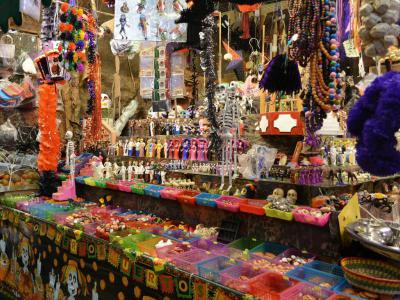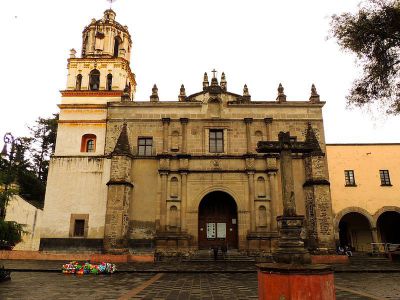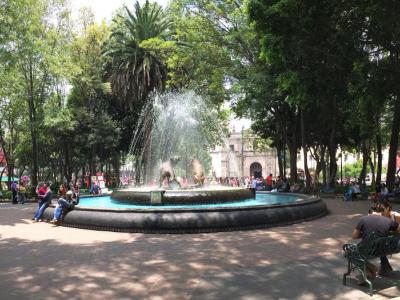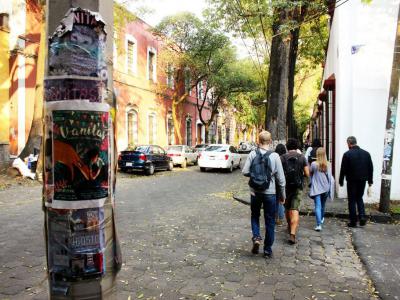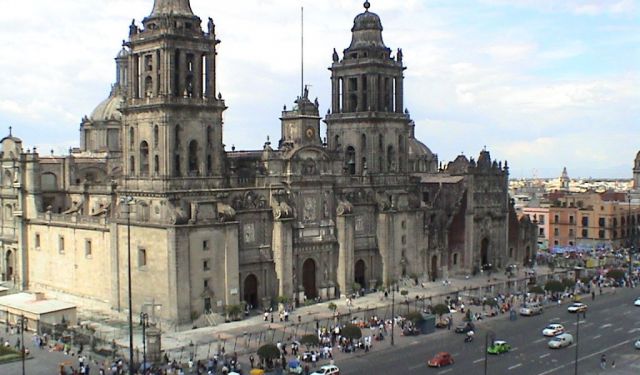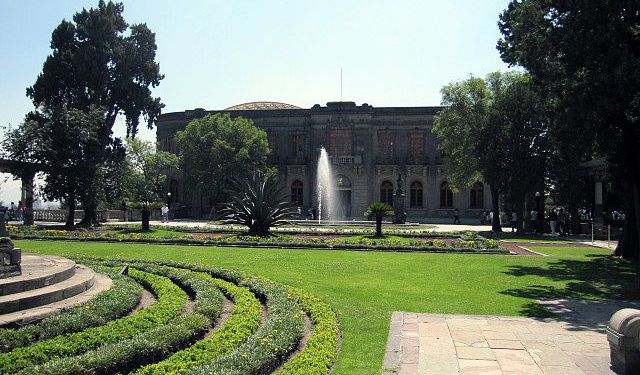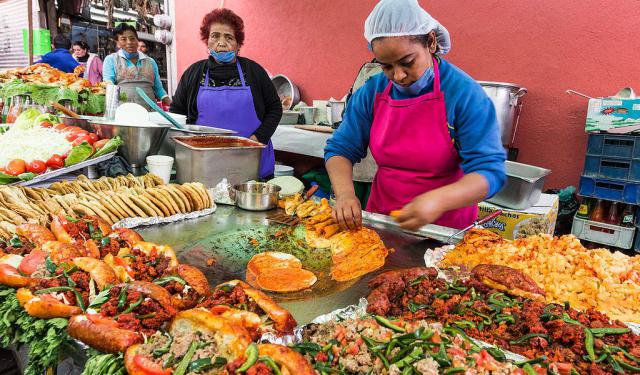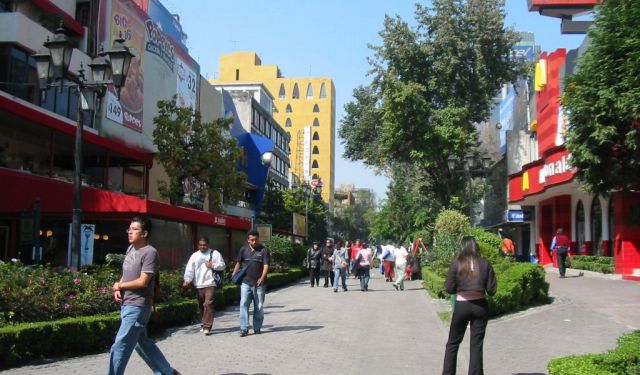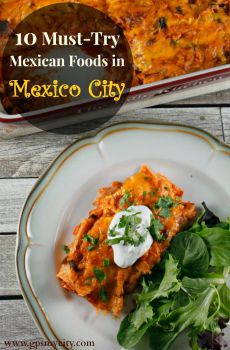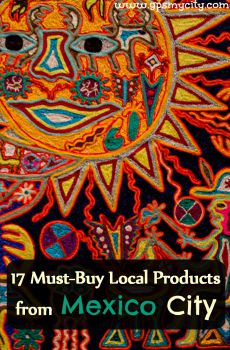Coyoacan District Walking Tour (Self Guided), Mexico City
Translated from the Nahuatle language as “The Land of Coyotes”, Coyoacán is a relatively quiet neighborhood in the southern part of Mexico City. Formerly a rural village, over the years Coyoacán has become a rich pocket of art and history in the capital, closely associated with some iconic figures of the 20th century and the tumultuous times in which they lived.
One of its most famous attractions is the Frida Kahlo Museum, also known as "The Blue House" (La Casa Azul). The former residence of the renowned Mexican painter Frida Kahlo, this museum provides a glimpse into her life and work, displaying her art, personal belongings, and the vivid atmosphere that inspired her creativity.
Another noteworthy historical site in Coyoacán is the Leon Trotsky House Museum. This is the property where exiled Russian revolutionary Leon Trotsky lived and worked before his assassination in 1940.
For those seeking local flavors and artisanal products, the Coyoacán Market is a must-visit. Here, you can explore a colorful array of food stalls, handicrafts, and souvenirs, immersing yourself in the vibrant local culture.
The Parish of Saint John the Baptist (Parroquia de San Juan Bautista) is a charming colonial-era church located in the heart of Coyoacán. Its architecture and history make it a significant landmark in the district, and it often hosts cultural events and religious ceremonies.
Coyoacán is also home to the Centennial Garden and the Fountain of the Coyotes, where you can enjoy a tranquil moment surrounded by lush greenery and the soothing sound of water, making it a perfect spot for relaxation and reflection.
Lastly, don't forget to take a stroll along Francisco Sosa Avenue, known for its cobblestone streets, colonial architecture, and numerous cafes and restaurants, making it an ideal place to enjoy local cuisine and soak up the district's unique ambiance.
It won't be an exaggeration to say that Coyoacán is a treasure trove of art, history, and culture in Mexico City, where the past and present seamlessly blend. If you wish to explore the unique spirit of this typically Mexican neighborhood and create your own memorable experiences, embark on this self-guided walking tour.
One of its most famous attractions is the Frida Kahlo Museum, also known as "The Blue House" (La Casa Azul). The former residence of the renowned Mexican painter Frida Kahlo, this museum provides a glimpse into her life and work, displaying her art, personal belongings, and the vivid atmosphere that inspired her creativity.
Another noteworthy historical site in Coyoacán is the Leon Trotsky House Museum. This is the property where exiled Russian revolutionary Leon Trotsky lived and worked before his assassination in 1940.
For those seeking local flavors and artisanal products, the Coyoacán Market is a must-visit. Here, you can explore a colorful array of food stalls, handicrafts, and souvenirs, immersing yourself in the vibrant local culture.
The Parish of Saint John the Baptist (Parroquia de San Juan Bautista) is a charming colonial-era church located in the heart of Coyoacán. Its architecture and history make it a significant landmark in the district, and it often hosts cultural events and religious ceremonies.
Coyoacán is also home to the Centennial Garden and the Fountain of the Coyotes, where you can enjoy a tranquil moment surrounded by lush greenery and the soothing sound of water, making it a perfect spot for relaxation and reflection.
Lastly, don't forget to take a stroll along Francisco Sosa Avenue, known for its cobblestone streets, colonial architecture, and numerous cafes and restaurants, making it an ideal place to enjoy local cuisine and soak up the district's unique ambiance.
It won't be an exaggeration to say that Coyoacán is a treasure trove of art, history, and culture in Mexico City, where the past and present seamlessly blend. If you wish to explore the unique spirit of this typically Mexican neighborhood and create your own memorable experiences, embark on this self-guided walking tour.
How it works: Download the app "GPSmyCity: Walks in 1K+ Cities" from Apple App Store or Google Play Store to your mobile phone or tablet. The app turns your mobile device into a personal tour guide and its built-in GPS navigation functions guide you from one tour stop to next. The app works offline, so no data plan is needed when traveling abroad.
Coyoacan District Walking Tour Map
Guide Name: Coyoacan District Walking Tour
Guide Location: Mexico » Mexico City (See other walking tours in Mexico City)
Guide Type: Self-guided Walking Tour (Sightseeing)
# of Attractions: 6
Tour Duration: 1 Hour(s)
Travel Distance: 2.6 Km or 1.6 Miles
Author: doris
Sight(s) Featured in This Guide:
Guide Location: Mexico » Mexico City (See other walking tours in Mexico City)
Guide Type: Self-guided Walking Tour (Sightseeing)
# of Attractions: 6
Tour Duration: 1 Hour(s)
Travel Distance: 2.6 Km or 1.6 Miles
Author: doris
Sight(s) Featured in This Guide:
- Frida Kahlo Museum (La Casa Azul)
- Leon Trotsky House Museum
- Coyoacan Market
- Parroquia de San Juan Bautista
- Centennial Garden and Fountain of the Coyotes
- Francisco Sosa Avenue
1) Frida Kahlo Museum (La Casa Azul) (must see)
Step into the vivid lifestyle of Mexico's affluent Bohemia as you enter the historic U-shaped house with its striking high blue walls, famously known as La Casa Azul (The Blue House). This remarkable place serves as a museum dedicated to celebrating the life and artistic legacy of the renowned Mexican artist Frida Kahlo, and stands as the most sought-after destination among museums in Mexico City.
La Casa Azul was once the cherished home of Frida Kahlo and her husband, the prominent muralist Diego Rivera, until her passing in 1954. Situated in the enchanting Coyoacán district, this house originally belonged to Frida's parents and holds precious memories of her upbringing alongside her sisters.
Within its walls, you'll find the former sitting room adorned with paintings of Frida's family, including her final masterpiece, 'Viva la Vida,' a vibrant still life capturing the essence of watermelons. The museum's exhibits also feature an intriguing collection of masks, colorful and elaborate costumes worn by Frida, as well as idols and giant papier-mâché Judas masks. The kitchen has been thoughtfully preserved, showcasing the household utensils of yesteryears, while the lush courtyard boasts a small pink stepped pyramid designed by Rivera, along with pre-Columbian idols and tropical paintings.
Following Frida's passing, Rivera generously donated the house to the Mexican people, and it was transformed into a museum four years later. Today, visitors can explore its wonders from Tuesday through Sunday, and to enhance the experience, there's a delightful gift-cum-tea shop located at the back of the museum for your convenience.
Why You Should Visit:
Colorful, intimate, fascinating museum in an awesome area! Since Frida Kahlo was a bright, colorful and eclectic decorator, the home is a joy to tour through and see how the artist designed and lived in her private space.
Tip:
The Coyoacán neighborhood has a beautiful central plaza and square with great restaurants, adorable coffee shops, a large market, beautiful and colorful homes, and great energy on weekends with plenty of activity in the parks and people walking around. If you visit the museum, it would be great to dedicate some time afterward to explore the surrounding area!
La Casa Azul was once the cherished home of Frida Kahlo and her husband, the prominent muralist Diego Rivera, until her passing in 1954. Situated in the enchanting Coyoacán district, this house originally belonged to Frida's parents and holds precious memories of her upbringing alongside her sisters.
Within its walls, you'll find the former sitting room adorned with paintings of Frida's family, including her final masterpiece, 'Viva la Vida,' a vibrant still life capturing the essence of watermelons. The museum's exhibits also feature an intriguing collection of masks, colorful and elaborate costumes worn by Frida, as well as idols and giant papier-mâché Judas masks. The kitchen has been thoughtfully preserved, showcasing the household utensils of yesteryears, while the lush courtyard boasts a small pink stepped pyramid designed by Rivera, along with pre-Columbian idols and tropical paintings.
Following Frida's passing, Rivera generously donated the house to the Mexican people, and it was transformed into a museum four years later. Today, visitors can explore its wonders from Tuesday through Sunday, and to enhance the experience, there's a delightful gift-cum-tea shop located at the back of the museum for your convenience.
Why You Should Visit:
Colorful, intimate, fascinating museum in an awesome area! Since Frida Kahlo was a bright, colorful and eclectic decorator, the home is a joy to tour through and see how the artist designed and lived in her private space.
Tip:
The Coyoacán neighborhood has a beautiful central plaza and square with great restaurants, adorable coffee shops, a large market, beautiful and colorful homes, and great energy on weekends with plenty of activity in the parks and people walking around. If you visit the museum, it would be great to dedicate some time afterward to explore the surrounding area!
2) Leon Trotsky House Museum
The Leon Trotsky House Museum in Coyoacán is a tribute to the Russian revolutionary, politician, journalist and political theorist Leon Trotsky and the organization that advocated political asylum. Its focal point is the residence where Trotsky resided with his wife and teenage grandson during his exile from 1939 to 1940. Tragically, it was also the place where the Russian communist dissident was assassinated on August 20, 1940, by Ramón Mercader, an agent of Stalin's NKVD.
The entire complex is enclosed by tall outer walls, complete with watchtowers, giving it the appearance of a fortress. This precaution was taken after a previous unsuccessful attempt on Trotsky's life on May 24, 1940, orchestrated by a group of NKVD agents with the assistance of Mexican painter David Alfaro Siqueiros.
The house, particularly the study where Mercader struck Trotsky with a fatal blow from an ice axe, has been preserved exactly as it was at the moment of the assassination, with papers and books in their original positions. Additional rooms within the museum showcase photographs, newspapers, and personal belongings of Trotsky, including his iconic small round glasses. The guards' house houses a permanent photographic collection, featuring images of Trotsky's family and his involvement in the Russian Bolshevik Revolution of 1917. Moreover, there are temporary exhibition halls that regularly feature artworks from various artists.
The surrounding garden is meticulously maintained, adorned with tropical flowers and plants, some of which were collected by Trotsky himself, including rare cacti. In the heart of the garden lies the tomb of Trotsky and his wife, marked by a stone stele and a flagpole with the Soviet flag. The transformation of the complex into a museum and asylum institution occurred in 1990, commemorating the 50th anniversary of Trotsky's assassination.
The entire complex is enclosed by tall outer walls, complete with watchtowers, giving it the appearance of a fortress. This precaution was taken after a previous unsuccessful attempt on Trotsky's life on May 24, 1940, orchestrated by a group of NKVD agents with the assistance of Mexican painter David Alfaro Siqueiros.
The house, particularly the study where Mercader struck Trotsky with a fatal blow from an ice axe, has been preserved exactly as it was at the moment of the assassination, with papers and books in their original positions. Additional rooms within the museum showcase photographs, newspapers, and personal belongings of Trotsky, including his iconic small round glasses. The guards' house houses a permanent photographic collection, featuring images of Trotsky's family and his involvement in the Russian Bolshevik Revolution of 1917. Moreover, there are temporary exhibition halls that regularly feature artworks from various artists.
The surrounding garden is meticulously maintained, adorned with tropical flowers and plants, some of which were collected by Trotsky himself, including rare cacti. In the heart of the garden lies the tomb of Trotsky and his wife, marked by a stone stele and a flagpole with the Soviet flag. The transformation of the complex into a museum and asylum institution occurred in 1990, commemorating the 50th anniversary of Trotsky's assassination.
3) Coyoacan Market
They say, if you want to get to know the daily life of an area, dive deep into its market. Established in 1921 (although the location has moved since), the Coyoacán Market, one of the icons of the Coyoacán neighborhood, is also one of Mexico City's most iconic shopping destinations. Whether you want to gawk at the rows of colorful products or snag some affordable textiles, this market is good for anyone who wants a truly local experience.
Particularly famous for its color, folklore and tradition, the Mercado Coyoacán has been selling everything under the sun for the better part of the 20th century through the 21st. Over this period, hundreds of artists have walked its halls, including the likes of Frida Kahlo and Diego Rivera, for whom Coyoacán was their hood. In addition to every Mexican market's staples, like fresh fruits and veggies, meat, groceries, etc., here you can find loads of snacks, full meals, juices and smoothies, crafts, costumes for all occasions, traditional Mexican clothing and toys, plants, gifts and even small birds (you name it).
In time for every seasonal festival, it has everything you can possibly need for decorating, cooking and celebrating the event. In December, for instance, it is common to find here numerous stalls selling romeritos, candy and piñatas, whereas in early November here are flowers and costumes for the Day of the Dead, while in September – hats, flags and everything else necessary for the national holidays then. There are also tonnes of souvenirs to choose from, and at the rather affordable prices too.
The complex covers an entire block of Del Carmen colony and has three large shops and a roof arch type of structure that once housed a flea market.
Tip:
Although not particularly great a place for handicrafts, if you are interested in seeing how the locals do their everyday shopping, this is your place. But be warned that the shopping alleys are narrow, so stay away if you're not a fan of tight, crowded spaces.
Souvenir prices here are much MUCH lower than elsewhere, e.g. the El Sabado Bazaar, so don’t even bother going there if you need lots of souvenirs.
Particularly famous for its color, folklore and tradition, the Mercado Coyoacán has been selling everything under the sun for the better part of the 20th century through the 21st. Over this period, hundreds of artists have walked its halls, including the likes of Frida Kahlo and Diego Rivera, for whom Coyoacán was their hood. In addition to every Mexican market's staples, like fresh fruits and veggies, meat, groceries, etc., here you can find loads of snacks, full meals, juices and smoothies, crafts, costumes for all occasions, traditional Mexican clothing and toys, plants, gifts and even small birds (you name it).
In time for every seasonal festival, it has everything you can possibly need for decorating, cooking and celebrating the event. In December, for instance, it is common to find here numerous stalls selling romeritos, candy and piñatas, whereas in early November here are flowers and costumes for the Day of the Dead, while in September – hats, flags and everything else necessary for the national holidays then. There are also tonnes of souvenirs to choose from, and at the rather affordable prices too.
The complex covers an entire block of Del Carmen colony and has three large shops and a roof arch type of structure that once housed a flea market.
Tip:
Although not particularly great a place for handicrafts, if you are interested in seeing how the locals do their everyday shopping, this is your place. But be warned that the shopping alleys are narrow, so stay away if you're not a fan of tight, crowded spaces.
Souvenir prices here are much MUCH lower than elsewhere, e.g. the El Sabado Bazaar, so don’t even bother going there if you need lots of souvenirs.
4) Parroquia de San Juan Bautista
Parroquia de San Juan Bautista, aka Iglesia de San Juan Bautista or Iglesia de Coyoacán, is a 16th century Catholic church and former mission dedicated to Saint John the Baptist, presiding over the south side of Plaza Hidalgo. To build this church, eight years after the conquest was completed, Hernán Cortés granted to a group of friars of the Roman Catholic Order of Preachers, better known as the Dominicans, a vast plot of land which he, in turn, had received from the native Ixtolinque chief baptized into the Catholic faith under the name of Juan de Guzmán.
Going in fits and starts between 1522 and 1552, the construction took place on the site of a calmecac, a school for the sons of Aztec nobility, whose ruins still remain beneath the cloister. In the course of over four centuries since, the original basilica has been remodeled several times, including in 1804 and from 1926 to 1947. In front of the church entrance is a cobblestone square that originally extended into what is now Plaza Centenario. A four-story bell tower, added in the 18th century, stands to the west of the main church and was once topped by a dome, lantern and cross. Sadly, the dome collapsed during an earthquake in September 2017.
The relatively plain facade of the church features the Herrerian style, named so after the Spanish architect and mathematician Juan de Herrera, and is almost entirely devoid of ornamentation. An inscription in Latin above the door translates to, “There is none other but a house of God, and this a gate of the heavens.”
Contrary to the plain exterior, the interior is quite exuberant in Baroque style, with gorgeous archways and illusion-inducing ceiling frescoes depicting scenes from the life of Jesus Christ and the saints of the Franciscan order. A single nave flanked by seven small chapels culminates in the magnificent Chapel of the Rosary, with its lavishly decorated high altar embellished with the glow of gold leaf and the Dominican order's coat of arms bas-relief featuring fleur-de-lis cross whose petals symbolize the 12 apostles.
In 1934, the church was declared a national historic monument, and in the 1980s became the site of an alleged Apparition of the Virgin of Guadalupe. If you can’t go to a city without exploring a few churches, the Parroquia San Juan Bautista will surely not disappoint!
Going in fits and starts between 1522 and 1552, the construction took place on the site of a calmecac, a school for the sons of Aztec nobility, whose ruins still remain beneath the cloister. In the course of over four centuries since, the original basilica has been remodeled several times, including in 1804 and from 1926 to 1947. In front of the church entrance is a cobblestone square that originally extended into what is now Plaza Centenario. A four-story bell tower, added in the 18th century, stands to the west of the main church and was once topped by a dome, lantern and cross. Sadly, the dome collapsed during an earthquake in September 2017.
The relatively plain facade of the church features the Herrerian style, named so after the Spanish architect and mathematician Juan de Herrera, and is almost entirely devoid of ornamentation. An inscription in Latin above the door translates to, “There is none other but a house of God, and this a gate of the heavens.”
Contrary to the plain exterior, the interior is quite exuberant in Baroque style, with gorgeous archways and illusion-inducing ceiling frescoes depicting scenes from the life of Jesus Christ and the saints of the Franciscan order. A single nave flanked by seven small chapels culminates in the magnificent Chapel of the Rosary, with its lavishly decorated high altar embellished with the glow of gold leaf and the Dominican order's coat of arms bas-relief featuring fleur-de-lis cross whose petals symbolize the 12 apostles.
In 1934, the church was declared a national historic monument, and in the 1980s became the site of an alleged Apparition of the Virgin of Guadalupe. If you can’t go to a city without exploring a few churches, the Parroquia San Juan Bautista will surely not disappoint!
5) Centennial Garden and Fountain of the Coyotes
If you seek to escape the bustle and clamor of Mexico City for a few hours for a chance of great lunch/dinner or a nice stroll in the park, or to enjoy some classic Spanish colonial architecture, or to find some cute, easy streets for a walk and photo shooting, you can find it all in the historic part of Coyoacán centered on two large plazas filled with Indian laurel trees, called Plaza del Centenario and Plaza Hidalgo, also known as Jardin del Centenario (Centennial Garden) and Jardín Hidalgo.
The two plazas cover a vast space of 24,000 square meters and were thoroughly renovated, paved with red and black volcanic stone, back in 2008, along with the surrounding streets. For decades, prior to the renovation, these plazas, especially Plaza Hidalgo, had been filled with vendors, most of which are now gone.
Plaza del Centenario, to the west of Hidalgo, is slightly smaller and originally formed part of the very large atrium that used to belong to Parish of San Juan Bautista during the colonial period. A stroll through Plaza/Jardin del Centenario is a must when visiting Coyoacán. In the center of it, there is a fountain featuring a bronze sculpture of two coyotes surrounded by jets of water, referring to the etymology of the borough's name (Aztec: “Land of the Coyotes”). Historians say, these animals were once commonplace in this part of the Mexican valley and, as such, bore a great significance in the Aztec cosmovision. The iconic Fountain of the Coyotes was built in 1967.
Another notable landmark here is Los Arcos del Jardin Centenario (the Arches of Centennial Garden). Together with the fountain they create a perfect setting for the weekend fun enhanced with various attractions such as music, craft markets, mimes, and street vendors. The garden was inaugurated in 1921 to commemorate the centenary of Mexican independence. The south side of the garden is lined with restaurants and a wide range of bars and cafes, including the well-known Café El Parnaso, offering a choice of Mexican food, ice creams and more.
The two plazas cover a vast space of 24,000 square meters and were thoroughly renovated, paved with red and black volcanic stone, back in 2008, along with the surrounding streets. For decades, prior to the renovation, these plazas, especially Plaza Hidalgo, had been filled with vendors, most of which are now gone.
Plaza del Centenario, to the west of Hidalgo, is slightly smaller and originally formed part of the very large atrium that used to belong to Parish of San Juan Bautista during the colonial period. A stroll through Plaza/Jardin del Centenario is a must when visiting Coyoacán. In the center of it, there is a fountain featuring a bronze sculpture of two coyotes surrounded by jets of water, referring to the etymology of the borough's name (Aztec: “Land of the Coyotes”). Historians say, these animals were once commonplace in this part of the Mexican valley and, as such, bore a great significance in the Aztec cosmovision. The iconic Fountain of the Coyotes was built in 1967.
Another notable landmark here is Los Arcos del Jardin Centenario (the Arches of Centennial Garden). Together with the fountain they create a perfect setting for the weekend fun enhanced with various attractions such as music, craft markets, mimes, and street vendors. The garden was inaugurated in 1921 to commemorate the centenary of Mexican independence. The south side of the garden is lined with restaurants and a wide range of bars and cafes, including the well-known Café El Parnaso, offering a choice of Mexican food, ice creams and more.
6) Francisco Sosa Avenue
Probably the cutest street in the Coyoacán, if not the whole Mexico City, and one of the oldest in Latin America, Francisco Sosa street is named after a writer, poet and journalist Francisco Sosa. As if pursuant to his legacy, the street has a truly poetic atmosphere manifested in colorful historic architecture, narrow sidewalks, painted address tiles and signage, cobblestones, huge trees and lush vegetation alongside. Thanks to the very little motor traffic, a stroll here feels like walking centuries back into the colonial period, when the road linked the then Coyoacán village to the village of San Ángel.
Today, the iconic street starts at the Centennial Garden Arcade and ends at the Panzacola Street bridge, lined along the way by as many as 65 listed monuments, including: Casa del Sol, the place where the Constitution of Mexico was written in 1917; Fonoteca Nacional, a former house of Octavio Paz, the laureate of the Nobel Prize for Literature; an extremely cute Plaza de Santa Catarina, with a chapel and colorful paper decorations hung across the place; the Italian Cultural Institute and many others.
One of the most notable buildings, sitting on the corner of Calle Francisco Sosa and Plaza de Centenario, is the Casa de Ordaz, long thought to have belonged to conquistador Diego de Ordaz, who died in 1532, but in reality built sometime around the 18th century. For those interested in art, there are Galleria El Circulo Azul and Museo Nacional de la Acuarela “Alfredo Guati Rojo” also worth checking out on the side street, called Salvador Novo.
Pretty quiet compared to most places in Mexico City, this avenue has a charming old world vibe, and is a great way to discover Coyoacán, especially in the morning, if you walk it West to East and then sit at a cafe on the lovely main plaza. The neighborhood abounds in nice cafes and restaurants, and has a great number of fruit carts along the way, so you can eat as you walk. It is also cool for a memorable photoshoot!
Today, the iconic street starts at the Centennial Garden Arcade and ends at the Panzacola Street bridge, lined along the way by as many as 65 listed monuments, including: Casa del Sol, the place where the Constitution of Mexico was written in 1917; Fonoteca Nacional, a former house of Octavio Paz, the laureate of the Nobel Prize for Literature; an extremely cute Plaza de Santa Catarina, with a chapel and colorful paper decorations hung across the place; the Italian Cultural Institute and many others.
One of the most notable buildings, sitting on the corner of Calle Francisco Sosa and Plaza de Centenario, is the Casa de Ordaz, long thought to have belonged to conquistador Diego de Ordaz, who died in 1532, but in reality built sometime around the 18th century. For those interested in art, there are Galleria El Circulo Azul and Museo Nacional de la Acuarela “Alfredo Guati Rojo” also worth checking out on the side street, called Salvador Novo.
Pretty quiet compared to most places in Mexico City, this avenue has a charming old world vibe, and is a great way to discover Coyoacán, especially in the morning, if you walk it West to East and then sit at a cafe on the lovely main plaza. The neighborhood abounds in nice cafes and restaurants, and has a great number of fruit carts along the way, so you can eat as you walk. It is also cool for a memorable photoshoot!
Walking Tours in Mexico City, Mexico
Create Your Own Walk in Mexico City
Creating your own self-guided walk in Mexico City is easy and fun. Choose the city attractions that you want to see and a walk route map will be created just for you. You can even set your hotel as the start point of the walk.
Historic Center Walking Tour
Mexico City is the oldest capital in the Americas and is one of the two founded by indigenous people. Originally known as Mexico Tenochtitlan, the city was built by the Mexicas (aka Aztecs) in 1325. According to a legend, the Mexicas' principal god, Huitzilopochtli, pointed out the site of the future settlement with an image of a golden eagle perched on a prickly pear cactus, devouring a... view more
Tour Duration: 2 Hour(s)
Travel Distance: 2.7 Km or 1.7 Miles
Tour Duration: 2 Hour(s)
Travel Distance: 2.7 Km or 1.7 Miles
Chapultepec Park Walking Tour
Nicknamed "the Lungs of Mexico City", Chapultepec Park is a vast oasis of lush greenery in the heart of the Mexican capital, sprawling over 686 hectares of land, providing a vital source of oxygen for the city. Rich in natural beauty, historical landmarks, and vibrant atmosphere, throughout centuries, this park has inspired various works of literature, poetry, and visual art, further... view more
Tour Duration: 2 Hour(s)
Travel Distance: 3.8 Km or 2.4 Miles
Tour Duration: 2 Hour(s)
Travel Distance: 3.8 Km or 2.4 Miles
Historic Center Food Tour
A combination of history and tradition in Mexico City permeates all aspects of life, including food. For centuries, food and drink have been an inseparable part of the city's culture. Within Mexico City's bustling historic center, you can find a variety of culinary gems that offer a taste of what we call diverse Mexican cuisine.
One of the must-visit spots here is the San Juan Market.... view more
Tour Duration: 1 Hour(s)
Travel Distance: 1.6 Km or 1 Miles
One of the must-visit spots here is the San Juan Market.... view more
Tour Duration: 1 Hour(s)
Travel Distance: 1.6 Km or 1 Miles
Zona Rosa Walking Tour
Zona Rosa, or "Pink Zone" in English, is a vibrant neighborhood near the historic center of the Mexican capital which is known for its lively atmosphere and diverse cultural scene. The neighborhood's name comes from the pink-colored tiles abundantly used to pave the local streets.
The area rose to prominence in the early 20th century as a residential district for the wealthy... view more
Tour Duration: 2 Hour(s)
Travel Distance: 3.7 Km or 2.3 Miles
The area rose to prominence in the early 20th century as a residential district for the wealthy... view more
Tour Duration: 2 Hour(s)
Travel Distance: 3.7 Km or 2.3 Miles
Useful Travel Guides for Planning Your Trip
10 Must-Try Mexican Foods in Mexico City
While Mexico is a treasure trove in terms of cultural and artistic heritage (ancient history, architecture, etc.), the vast majority of visitors to the country are lured mainly by, let's face it, bodily pleasures. The latter are manifested in the form of sandy beaches, sun and, most...
Souvenir Shopping Guide: 17 Must-Buy Local Products from Mexico City
Both historic and modern day Mexico's are worth each other in terms of cultural and artistic heritage. The country's capital Mexico City is a showroom of what the label "Made in Mexico" stands for in its entirety. Whether it's authentic food, drink or piece of craftsmanship...
The Most Popular Cities
/ view all
